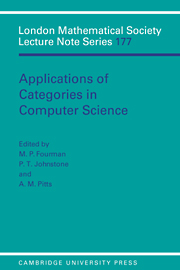 Applications of Categories in Computer Science
Applications of Categories in Computer Science Published online by Cambridge University Press: 24 September 2009
Introduction
The diagrams for symmetric monoidal closed categories proved commutative by Mac Lane and the author in [19] were diagrams of (generalized) natural transformations. In order to understand the connexion between these results and free models for the structure, the author introduced in [13] and [14] the notion of club, which was further developed in [15] and applied later to other coherence problems in [16] and elsewhere.
The club idea seemed to apply to several diverse kinds of structure on a category, but still to only a restricted number of kinds. In an attempt to understand its natural limits, the author worked out a general notion of “club”, as a monad with certain properties, not necessarily on Cat now, but on any category with finite limits. A brief account of this was included in the 1978 Seminar Report [17], but was never published; the author doubted that there were enough examples to make it of general interest.
During 1990 and 1991, however, we were fortunate to have with our research team at Sydney Robin Cockett, who was engaged in applying category theory to computer science. In lectures to our seminar he called attention to certain kinds of monads involved with data types, which have special properties : he was calling them shape monads, but in fact they are precisely examples of clubs in the abstract sense above.
In these circumstances it seems appropriate to set down those old ideas after all, and to complete them in various ways, in particular as regards enriched monads.
To save this book to your Kindle, first ensure no-reply@cambridge.org is added to your Approved Personal Document E-mail List under your Personal Document Settings on the Manage Your Content and Devices page of your Amazon account. Then enter the ‘name’ part of your Kindle email address below. Find out more about saving to your Kindle.
Note you can select to save to either the @free.kindle.com or @kindle.com variations. ‘@free.kindle.com’ emails are free but can only be saved to your device when it is connected to wi-fi. ‘@kindle.com’ emails can be delivered even when you are not connected to wi-fi, but note that service fees apply.
Find out more about the Kindle Personal Document Service.
To save content items to your account, please confirm that you agree to abide by our usage policies. If this is the first time you use this feature, you will be asked to authorise Cambridge Core to connect with your account. Find out more about saving content to Dropbox.
To save content items to your account, please confirm that you agree to abide by our usage policies. If this is the first time you use this feature, you will be asked to authorise Cambridge Core to connect with your account. Find out more about saving content to Google Drive.